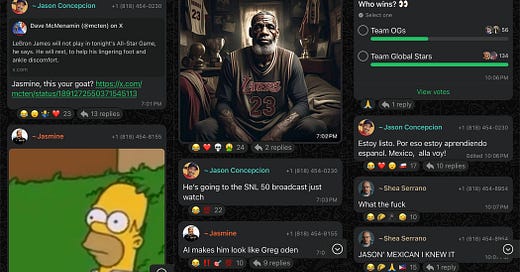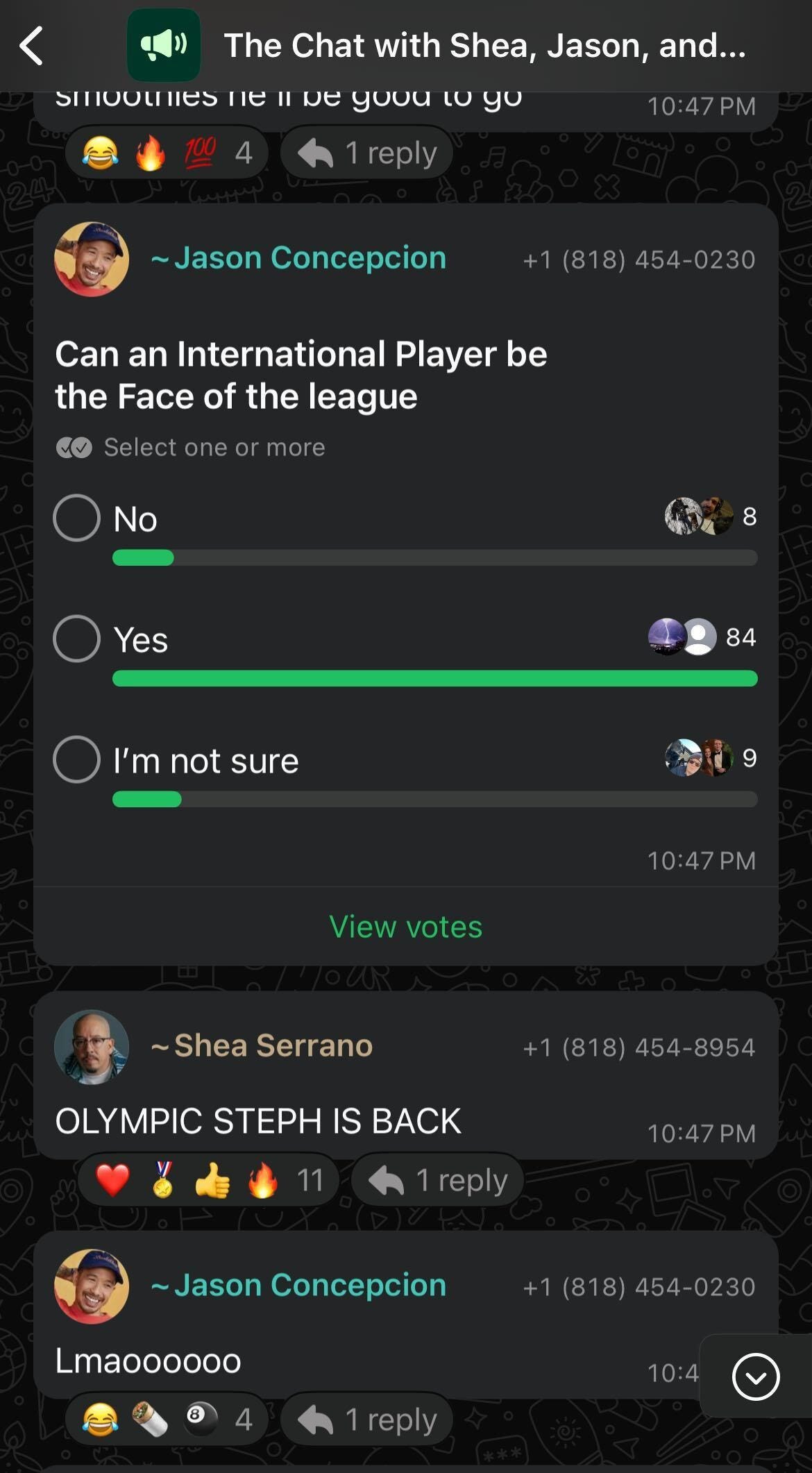Creators, group chats and the next frontier of second-screen content
Leaning into creator-led experiences via a very familiar platform
This past Sunday, the NBA rolled out a new format for its annual NBA All-Star game. Instead of a singular game between two teams, the new format introduced a mini-tournament comprising four smaller teams across 32 NBA All-Stars and Rising Stars. The teams competed in a semifinal-and-final style tournament in first-to-40 games.
The change was set after a slew of criticism rained all over the NBA’s traditional format in 2024 — a game that consisted of minimal defense and a final score that totaled nearly 400 points.
But don’t worry — this edition of The Churning Point isn’t here to advocate for or criticize the struggles the NBA has had with its All-Star weekend over the years. Instead, it is here to make an interesting observation about a trend emerging in what I’ll call the “second-screen content” space — that is, how audience members are consuming live events with a second screen.
Second-screen content is far from a new concept. Ever since the emergence of smartphones and social media, younger audiences have gravitated toward second screens to engage in social conversations, polls, gambling, quizzes and more during live events (or what I will refer to as “main event content” throughout this post).
But one avenue audiences have traditionally used to interact with content is making a comeback — the group chat. While platforms like Twitter/X and Facebook have traditionally hosted these conversations, traditional churn, changes in censorship, political influence, relationships with creators, and a general appetite for a change in the way content is marketed have all disrupted and fragmented how audiences engage with main event content.
Marketing newsletter SCAN 👀 CLUB produced a helpful analysis of what audiences are looking for in the digital content space in 2025. In a recent post on the blog, Creative Director at Arcade Studios Alyssa Yuhas put together the five trends audiences crave in 2025, which are the following:
Audiences want to be seen
Audiences want realness
Audiences want shared moments
Audiences want to play
Audiences want ease
Below, I’ll argue how the emerging resurgence of the group chat as second-screen content is the key that can turn the lock for all five of these audiences’ needs.
📊 A “Dandex” breakdown
The “Dandex” is a common theme throughout my articles. Simply put, it’s just a breakdown, but if you want to amuse me, it’s a simplified index categorized into different answers to the (how are group chats are key to unlocking audience engagement?) question presented above.
In this breakdown, I will focus on OffBall, a sports and culture content curation platform. The brand has also been at the forefront of using group chats, direct SMS messaging and email to distribute content, record feedback and interact with its audience.
Offball was an active participant during the 2025 NBA All-Star Game on Feb. 16. In a partnership with WhatsApp, Offball launched The Chat. In The Chat, high-profile users — creators, celebrities, and athletes — serve as hosts, with an audience watching and engaging with specific messages from the creators via emojis and comments. Sports media personalities Jason Concepcion, Shea Serrano and Jasmine Watkins were the three hosts during the NBA All-Star Game.
👀 Seeing Audiences — During the NBA All-Star campaign with WhatsApp, Jasmine, Jason and Shea were back and forth, slinging takes, cracking jokes and sharing amusing AI art and memes, as audiences watched the conversation play out, a la a podcast but in written form, and during a live event. Not only could fans directly react to messages with emojis they could also respond to each message in a thread format. Throughout Sunday’s Chat, Jasmine, Jason and Shea would always tip their respective hats to the audience.
🗣️ Being Real — In SCAN 👀 CLUB, the second trait audiences want that Alyssa Yuhas laid out was authenticity, especially relevant in a digital landscape full of AI-generated slop and noise. Yuhas broke this authenticity down into six bullet points:
Transparent communication
Emotional connections
Storytelling, nostalgia and relatable branding
Campaigns with aspirational figures
People over polish (messiness is in)
Unscripted moments to cheer for
Not even diving into the authentic nature of the conversation Jasmine, Jason, and Shea were having on WhatsApp (something not unique to a group of friends just chatting about what’s happening on the main screen), a group chat itself is about as authentic or real an experience an audience can have. The biggest factor here is trust, but when you bring in established media personalities with a history across sports Twitter/X (the three total over 700k followers on the platform), it’s easy for the audience to recognize when these digitally-native personalities aren’t being themselves. I would argue that this trust is similar to what we have seen across the creator community in recent years, especially when it comes to sports and the explosion of podcasts.
🖼️ Shared Moments — This box is checked pretty quickly in the context of having a group chat surrounding a live event. It’s why the second-screen experience was such a revolution throughout the 2010s in the first place. Something is happening in the world — so, let’s all gather in a digital community to discuss, ridicule, laugh with/at or make memes about the event happening. As audiences continue to fragment and the monoculture continues to winnow, having shared moments to all gather around authentically means more and more every day.
🙋 Let’s Play — In the context of a siloed environment like a WhatsApp community group chat, establishing games and shareable engagement (like polls, meme/art sharing, etc.) can be easily built into the experience. During Sunday’s All-Star game, Jasmine, Jason and Shea weren’t the only ones experimenting with polls, as OffBall’s admin was also in the chat facilitating conversation and engagement tactics. While this is just the beginning of OffBall’s partnership with a platform like WhatsApp, it isn’t unusual for brands to form and engage with communities in chat-like settings. Discord is another platform with built-in chat that allows developers to create unique communal experiences like games and digital scavenger hunts.
🏖️ Make it Easy — Yuhas notes that low-tech gadgets from cassette players to anti-smart phones are making a comeback among younger generations, emphasizing that a platform that is familiar and native with audiences is just as important as the content itself — in other words, the ease is the point. Platforms that require too much engagement might be a detriment to the overall value of a particular campaign’s desire to engage with an audience. This is an important note when contemplating other platforms (and might be a strike against Discord if there isn’t already an established expectation that your kind of content thrives there — for example, Discord is popular among gaming, gambling and cryptocurrency communities but probably not regular sports fans). Group chats, on the other hand, whether handled via WhatsApp, Telegram, or other simple messaging apps, can help hang onto that value while also enhancing engagement when done correctly.
🚀 From OffBall and into the beyond
While OffBall’s execution with WhatsApp and general SMS communication has been impressive up to this point, I can’t help but imagine how this strategy can produce all sorts of other campaigns (even outside of sports) — with creators or brands with much larger built-in audiences. Could SNL superfan and successful podcaster Bill Simmons have hosted a WhatsApp with his chosen guests and chatted with them as SNL 50 was airing live? Absolutely. Could you sell ads, sponsorships or sponsored content against this type of “viewing gallery”? Sure. Could you do the same thing but with the Mannings during the next Super Bowl? Why not? Pair your creator with an appropriate event that you may not even have live rights for, and see how the audience blossoms. While this phenomenon is in the early stages, at the end of the day, group chat communication grants creators and brands two massively desired characteristics in the digital content space today — authenticity and community.






